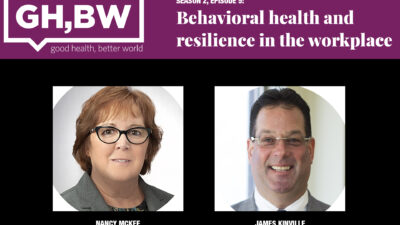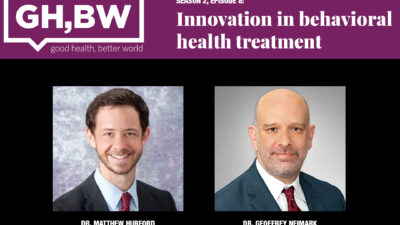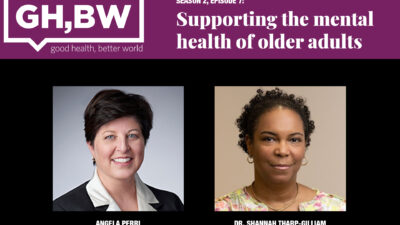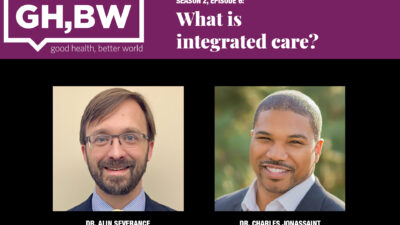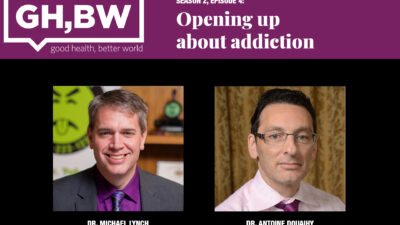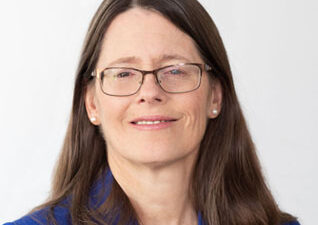In this episode:
Healthy, happy employees mean a better workplace. What can employers do? Guests James Kinville and Nancy Mckee of UPMC Health Plan’s LifeSolutions discuss why behavioral health care should be an important area of focus for employers and how an employee assistance program can support resilience and a culture of wellness.
Have questions? Email us at [email protected]
Resources:
Are you experiencing a crisis or are concerned about a loved one?
- Find out if your company offers an employee assistance program. These confidential programs are designed to link people with counselors, and other professionals.
- LifeSolutions is UPMC Health Plan's Employee Assistance program; to learn more, call 1-800-647-3327.
- For general help, Allegheny County residents can call resolve Crisis Network which provides crisis counseling for a variety of issues, at 1-888-796-8226, or click here.
- For help with addiction, call the Substance Abuse and Mental Health Service Administration's hotline at 1-800-662-4357, or click here.
- For general resources on addiction and mental illness, visit the Substance Abuse and Mental Health Services Administration, here.
- For help with a mental health crisis, reach National Alliance on Mental Illness by dialing 988, or click here.
- To reach UPMC Western Psychiatric Hospital and UPMC Western Behavioral Health, call 1-877-624-4100, or click here.
- UPMC Health Plan members can learn more about behavioral health programs, tools, and resources, by clicking here.
- To learn more about Community Care Behavioral Health, click here.
More:
From Harvard Business Review, how to move forward when you feel frozen. Get the story, here.
Psychotherapist Jonathan Kaufman writes in Forbes: “One of the most noteworthy changes in the culture of work is that the separation of one’s home and work life is becoming more diluted. This substantial change is creating new pressures and hassles that we are only beginning to discover.” Read more, here.
The National Council for Mental Wellbeing offers more information about Mental Health First Aid, here.

Dr. Ellen Beckjord: In this episode of Good Health, Better World, we're going to talk about behavioral health and resilience in the workplace. We'll talk with Jim Kinville and Nancy McKee from LifeSolutions, UPMC's Employee Assistance Program. Jim is the senior director of LifeSolutions with over 20 years of experience in managed care and specialty health management. Nancy is the clinical director and a registered nurse with extensive background in behavioral health. Jim, Nancy, welcome to Good Health, Better World.
Let's start by talking about decision makers at companies who know the value of health care that supports their employees’ physical health. But why is it important for employers to also focus on total health and thinking about behavioral health being a large part of total health? Jim, can you comment on whether you think employers are giving ample attention to behavioral health and why it's part of the total health package?
James Kinville: Thanks, Ellen. By far today we're experiencing more than ever, especially what's happened over the last two years, an increase in the awareness and the importance of individuals’ mental well-being. And certainly, we see the outcome of that in all of the workforces that we provide services for, particularly as it relates to the individual's overall well-being, connected with physical health, connected to areas of their work-life balance, and also in areas of their production and quality of work that they're delivering in the workforce. Inevitably, all of the things that we've been challenged by over the last two years have made an impact on an individual's personal and work life. And more so than ever, what we're finding is that employers are definitely more sensitive and definitely more interested in the overall mental well-being of their employee workforce.
Dr. Ellen Beckjord: And seeing it really tied to things like retention and productivity in the workplace?
James Kinville: Absolutely. I think what we're finding now, we hear a lot about the Great Resignation. We hear a lot about other areas that there's more opportunities for individuals within the workplace. And clearly, I think as employers look at those incentives as how they can attract talent, clearly this is a huge aspect for employers to look at how they can promote and encourage the mental well-being of a new workforce. And individuals are looking for that. They're looking for a culture that's going to embrace that overall mental well-being and that overall focus on how they can really get through a workday and also balance it with their personal life.
Dr. Ellen Beckjord: Nancy, can I ask you to comment on things employers can do to really create a space where employees feel supported and where they can feel validated or heard as challenges associated with behavioral and mental health might come up for them?
Nancy McKee: Absolutely. I think one of the things that employers have to do is learn to listen and just hear. You don't always have to have an answer. You don't have to know what to do that minute. You have to know that if you give it some time and thought, there may be a better solution for how you move forward.
When I hear the word resilience, one of the things that I hear from employees often is that more is being asked of me, whether it's at home, whether it's at work, but it comes into the workplace, right? So, I think one of the things that I try to teach people is that resilience is an action word and you have to take action. You have to take some steps to make it better for yourself, whatever that may be. But you need to have a personal inventory, like what's going on with me right now that I don't feel so resilient?
Dr. Ellen Beckjord: When I think about all of the ways we've had to adapt because of the pandemic and ways that that's caused stress that we're being called upon to be more resilient. But I'm curious, Nancy, and then you, Jim, on your perspective about whether the demand to be resilient has increased and if that maybe even predates the pandemic, if that's been growing for some time, even outside the context of COVID.
Nancy McKee: I think that's a really good question. Jim and I talked about this…there's just more going on in the world and so that can affect each of us differently. Some of it may not affect us at all, and some of it may impact us in ways that people don't know.
And I always think the important thing is we don't know people's stories. We don't know what they're carrying or what they're bringing into the workplace. And we used to say, leave your, leave your personal life at the doorstep. Well, your personal life may be at your doorstep because you're working from a hybrid model or a remote location. So, we're asking people to look at it differently than they did before. I think we've always asked people to be resilient and to know themselves. But this is a little different.
James Kinville: Yeah, when I think of, when I think of resiliency, I think of it as the opposite of burnout. And I think when you think about burnout, it certainly has an impact on our complete life. Burnout typically gets associated with the workplace, but when you think of it, it really, those behaviors can't only isolate themselves to the workplace. And when you think about resiliency, it's really, I think, areas of optimism, it's areas of having a zest for life, it's having energy, it's being able to be organized, it's being able to be creative. Those are all the things we want, right? Those are all the things that we want, not only for ourselves personally, but we also want those in the workplace. That can only be positive for an environment in the workplace. If all of those things are in sync, that means the work environment is going to be that much more positive.
Dr. Ellen Beckjord: I think that's a great description of what employers can really expect when their workforce is healthy in body and mind. That, not just productivity but creativity and good collegiality in the workplace, all the things that really are associated with just better outcomes as people are trying to navigate their career in the work that they do. Which brings me to the really vital role of employee assistance programs, which are not a part of every workforce experience, but, but several of them. And so, Jim, can you tell us, what is an employee assistance program and how does it function to help support employees and to support leaders as they seek to really optimize and support their workforce?
James Kinville: Thanks, Ellen. And in the spirit of us focusing on resiliency, I would say the first thing is an employee assistance program, it's the responsibility of that program to enhance and to activate the best culture of organizational resiliency that it can be. And that not only involves the workplace itself, but it also involves all of those employees. It involves all of those employees, families, their loved ones and their household members.
So, our services really expand the spectrum of any individual within a workplace. So, when we think about the employees, the family members, the loved ones, the household members, we have ultimate support of services that we can deliver to them for any particular mental well-being need that they may have. In addition, they may have other needs that they want to improve themselves in various aspects of life, whether it's learning a new skill, learning a new leadership quality, learning a new way to get organized.
But certainly, you know, a primary element is how can we support them from an overall mental well-being perspective, which can involve counseling, it can involve, you know, strategies for coping mechanisms, coping skills, etc.. On the other end of the spectrum, what we can also deliver is how do we support the organization in improving their culture? And it really starts with what can we do for leadership? How can we enhance their skills? How can we make them better leaders? How can we encourage them to bring awareness to mental well-being? How can we make them more effective listeners?
In the spectrum of EAP, we have a variety of other areas to support individuals, and certainly when we talk about the variety and the sadness of what we describe as disruptive events, critical incidents, unfortunately, those are real.
We also, I think, a couple other things to just highlight here is we also make sure that we gear our services to unique populations. So, for instance, to give you the spectrum of a couple, a couple of things. We have individuals that are starting a new family. So, we can certainly support new moms, new families, new parents with all kinds of resources for that great life event.
On the other end of the spectrum, we have obviously the older adults where there's an awful lot of need in the areas of caregiving. We have services that can support them with legal support. We have services that can help them with their financial wellness, which we know that's also one of the top three areas of challenge and stress that individuals are going through.
And then we also have just a lot of other courses and classes that we teach along that spectrum for personal enrichment and for personal growth, etc.. So, I think it really, you know, we joke about this that EAP is really the “kitchen sink” of anything and everything that really involves mental well-being counseling, behavioral health, work, life balance, etc..
Dr. Ellen Beckjord: I'm curious if you can comment on whether you've seen an increase in utilization of EAP services over the last couple of years? And if you want to share, either of you, any specific examples of services or programming for staff and for leadership that really stand out as ones that you're either getting lots of requests for, or ones that you feel like have been especially impactful over the past couple of years or even currently?
Nancy McKee: Yeah, I think the one thing that we're seeing, and this is to add to what Jim has said, that I think leaders need to know that we're there to support them in ways that sometimes it's just consulting with us. How do I handle this? What do I say to somebody? And not walking away from something that's a problem. But really early intervention is really key and being able to say there's been a change, you don't have to say much to the employee. You can hand them a little EAP card that said here, why don't you call them now? That's just an introduction to how they can come to our services.
But I think we have seen more, you know, for a while more people were working from home, they're coming back. So, we're seeing increased issues dealing with that reengagement in the workplace. And how does it work and do I really need to be here or can I stay home more? And I think that's a question that all employees are asking each other. And it's a pretty, it's, it's a question that you're just not going to know the answer to all the time. So we have to work together on this. And I think that if you're resistant to change, that's going to be the hardest time for you.
Change is hard for everybody. So, I would say just give it a few minutes. Take an inventory. What makes this so hard for me? How do I see this as a problem? And employers the same way. How could this be hard for our employees and what can we do to better engage them in this process? And I think that's the thing that Jim talked about is the articles and the information that UPMC puts out there from Workpartners. It's really good information, just to kind of sit back and think.
Dr. Ellen Beckjord: And as you talk about the challenges of change, it calls to mind for me again, the importance of resilience. That change is difficult, but resilience is sort of a key construct to help us be able to successfully navigate and manage the stressors that come with change. But Nancy, you mentioned Workpartners. And so, I just want to make sure for our listeners, we've talked about employee assistance programs and at UPMC, our employee assistance program is part of our company Workpartners.
Jim, would you like to say just a few words about Workpartners and how it fits into the bigger UPMC ecosystem?
James Kinville: Yeah. Thanks, Ellen. Yeah, we have a very unique and positive approach and directions that UPMC has created by really creating a division of services and support to employers that really outline very critical areas of their benefits. So, when we think about all of the other administrative components of a benefit offering, UPMC 25-plus years ago, created a division to focus specifically on areas like work comp and safety.
We also added on over the years services that we can provide support for leave in absence and those elements of a benefit that individuals use for a variety of reasons. We also have added EAP, of course, what we're focusing a bit on today.
We also include all of our health and wellness offerings. So, from opportunities for incentive programs, opportunities for health coaching, opportunities for a variety of other trainings and learnings on how you can improve your wellness. We also have offered a full enhanced and very sophisticated data analytics system that really can overlay all of those areas to really help employers. And it's helped UPMC greatly to understand what's going on with your employee workforce in all of those areas, because quite frankly, all of those things are connected when we think about an integrated approach.
So, if they happen to get injured at work, inevitably their pay is going to be adjusted during that time. Inevitably, they're going to go through the emotions of what the impact of that injury was. There are probably going to be family dynamics that are going to be sensitive.
We clearly can come in and provide a lot of great EAP support to them. So, our ability to wrap around all of these services together is just quite phenomenal. On the wellness side, when you think about somebody who gets diagnosed early on with being a pre-diabetic, inevitably a lot of emotion to that, right? A lot of concern, fear, anxiety.
We can certainly come in and we can help the individual cope with some of those emotions. So, a couple of examples of, very uniquely, of how we tie it all together to really build, I think, a better workforce at the end of the day.
I just want to go back to a couple of the comments that Nancy made about the workforce. Just the level set for us, too, when we think about it and this will be some of the general data that we see out there of late.
If you go back to your workplace and you look around the office and if there's 20 of you in a room, you know, inevitably there's going to be upwards of probably 12 or 13 folks that are going through something. I think to Nancy's point, there's a story that we all have.
We also have found that over 200,000 kids lost, lost a parent during COVID, and so when you start to look at some of these data points and you put them all together, you start to recognize we are in the midst and have been in the midst of a pretty significant mental well-being need and challenge that we have.
And so, for us, I think as Nancy pointed out, when we go into an employer group and work with them, this is the culture that we want to help support. And I think when you think about opportunities for employers to look at what they can do, we're talking a lot about this today, breaking down the stigma. Are they talking about it?
One of the great programs that we operate and run is we provide training. It's called Mental Health First Aid Training. We recommend it to all of our groups and all of our leaders. It's an opportunity to help recognize the signs and symptoms of mental well-being issues within the workforce.
I think the other things that we see and we consult with employers on what they are doing creatively and uniquely with their employees during the day? Are they offering stress breaks? Are they offering mental well-being breaks or are they offering, you know, chair yoga? Are they offering some of these other wonderful meditative mindfulness-related activities?
The other thing we've talked a lot about, and I want to emphasize this point is how are they making their employees feel valued? Are you getting to know your workforce? Do you know something personally about your workforce? Do you know people have kids or people got married or people are, you know, having other exciting things going on in their life? That's what brings people together and makes them feel valuable.
Dr. Ellen Beckjord: You know, when Nancy was talking about keeping your personal life at home and not bringing it into the workplace, and you pointed out that the increase in the degree to which we're often working from home, you know, really sort of challenges that idea. And then, of course, we've talked about how, as we go to either a distributed or a hybrid workforce model, so much of how we used to do things has changed.
That's not to say that it's worse or that it was better, or that it can't still be possible to drive a really strong culture in a workforce that hits on all of the really important things you've both been talking about. But it has really blurred the lines when people are working from home part or all of the time more frequently now between home and work.
And I'd love to hear from both of you. And maybe, Nancy, we can start with you, about ways you've seen employers become more creative about supporting employee wellness in distributed or hybrid workforces.
Nancy McKee: I think what I'm seeing is that the supervisor, leaders, and HR are bringing us into the work environment. So, they may have a group of employees that they want us to talk to or work with. And that's very helpful because I think on a personal basis, we still have some stigma that we want to get over. Coming to EAP does not mean a diagnosis. Coming to EAP is very personal and it's, and oftentimes employees will say to us, oh, that's all it is, you're listening to me. And I feel validated. And that's while at times that's what they want, just to feel validated. So, I think supervisors who've used our resources are really good about saying to somebody, I think this could be helpful to you.
And they're not embarrassed to say, I've called EAP, I've used it myself and it's been helpful. So, we see that quite and hear that quite often and it's really comforting. We've done some, we're doing some groups for one of the leaders that, you know, I'm getting good feedback from is that they like, employees like talking to each other because they may have lost that. And the employer has kind of worked it out so they have a little time in their work time to be able to, to do that and benefit from that. So, I think that's the creativity we're seeing from supervisors and human resources.
James Kinville: You know, when you think about it, two years ago, the country, the world had to pivot within a couple day period of time and how we were going to run all of our businesses and how we're going to manage all of our people from home. The workforce at that time, for us, we do an awful lot of work supporting our frontline workers and their life changed in different ways. They obviously aren't working remotely, but clearly, for all of the reasons that we know, their life changed completely as well. And so that was certainly an area of opportunity for us to get to those leaders, to get to those individuals that were having to continue to be in the workplace under very tumultuous times, dealing with a lot of trauma, a lot of grief, a lot of loss, but then also at home, having to balance at home when the world was going through the crisis.
And so, us being able to get into those areas also changed significantly to the positive and the positive being that this whole virtual opportunity for us to communicate has blossomed into a very significant and important element of how we deliver our services, not only for the convenience sake of it, but also accessing more people. And so, one of the practical things, obviously, as Nancy is mentioning is the fact that this channel has now opened up us to more people than we did when it was pre-pandemic and everything was in person. We've done more trainings, more consultations, more therapy than we've ever done over the last couple of years because of that channel alone.
So again, I think that's another element, a practical element, I think of how we can reach folks. The other thing, I think it's been a good outcome of having to really learn how to manage differently. Managing somebody in the office is completely different than managing somebody remotely. So being able to consult, being able to offer our expertise in ways to affect that positively has also been hugely beneficial to leaders, to managers, supervisors, etc.
Dr. Ellen Beckjord: Listening to you recount March of 2020, thinking about how much has happened since then and how we're at a very different phase of the pandemic right now. But all of the pivoting that had to happen, all of the stress and the tremendous burden on frontline health care providers, it's still hard because in many ways we're very much still in it to try to take a step back and appreciate just how much has changed and how much has happened.
But as I was listening to you talk, Jim, I, I feel like we've been pretty resilient. I feel like I feel like as a, at least I guess I can speak from the UPMC perspective and, the part of the world that I live in on the Insurance Services Division side, I feel like we've been pretty resilient. What do the two of you think?
Nancy McKee: I think we certainly have, have worked on that. I think that we have come up with even our creative ways. I think it's important that we keep all that in the forefront. It's not just one day that we're resilient. It's that we keep being resilient, that we keep looking for ways and keep hearing employees and keep hearing leaders tell us what would work best within their environment.
I think that we have a really a nice platform to bounce off of. And I think that's been really helpful because I don't know that everybody knows that, that other people need that support and help. And I like that we have our RxWell as well, the digital tool, and we use that quite frequently with them coming to talk to us.
Dr. Ellen Beckjord: And I'm glad that you mentioned RxWell, which just briefly, as you said, is a mobile application that has lots of education and techniques that can help people with anxiety, depression, stress, nutrition, physical activity, smoking cessation, sleep, even family coaching.
So, digital tools like that, I think, play an important role in helping people really maintain the work that they're doing to support their own resilience or well-being. Jim, did you have thoughts about our overall resilience?
James Kinville: You know, I believe that all of us are resilient in our own ways, and it's a matter of how do we continue to adjust to that level of resiliency for the type of situation at hand. And certainly, over the last couple of years, everybody's resiliency has been tested and certainly has been challenged. You know, by some estimates, there's going to be an increase of 35 million more individuals who are going to be raising their hand to get help with some level of mental well-being.
So, when you think about that, that's 10% of our population. And I look at that as a good outcome of resiliency because people are raising their hand, they're de-stigmatizing mental health, they're looking at ways to improve those aspects of their life.
And the other cool thing that I think is sort of an element of resiliency is thinking about all of the wonderful ways people can get support to enhance their mental well-being. You know, we've touched upon our internal digital behavioral cognitive app that we have created with our great experts and scientists like yourself, Ellen.
But when you think about all the other options that people have now more than ever, you know, over the last couple of years, and so there really is, I think, so many different ways people can get supported with their mental health these days. It's not just counseling, it's gosh, it's counseling, it's telephonic counseling, it's virtual, it's video. If they're interested in an app, there's literally thousands of different apps they can use. But the point to all that is people are now recognizing it's okay to talk about your mental health.
Dr. Ellen Beckjord: I agree and I love the idea of resilience. I think one of the things I really like about resilience is that kind of, you know, if you've heard the saying sort of people talk about how being courageous doesn't assume the absence of fear. Right. It's sort of assumes the presence of fear. There's no reason to be courageous if you aren't afraid. And I think that resilience operates in a similar way. Like resilience doesn't assume the absence of challenge. In fact, it assumes the presence of challenge. It assumes that a person is challenged, is being stressed by something, and yet perseveres.
And I'm thinking back to a conversation we had leading up to this episode when, Nancy, you talked about the importance of people feeling empowered to help themselves. And I wonder if you could just talk a little bit about that and its, its role in resilience overall?
Nancy McKee: I think resilience starts with each of us. We have to know who we are and we have to know what's getting in our way. And sometimes we have to declutter, declutter our brain.
I think that sometimes we have so many things going on that you have to kind of prioritize, like, what can I do right now that can change, that will help me get to the next step. So, we're talking about small steps. We're talking about you being the person in control of that. There are things in our world that we're not in control of. And I, all I will say to people, draw that. Draw a circle around yourself, and what's outside that circle oftentimes, we can't control.
So, to be resilient as (to) what's in our circle that I can make a difference with, that I can change that I can start today and even if it's something little, I have control over that. That's saying I'm in charge of me.
Dr. Ellen Beckjord: I love that. The last question that, that I'll ask both of you to please speak to is one that we're visiting pretty regularly with guests on the podcast this season, which is, if you think about the landscape of opportunity and improving behavioral health, or I'm happy to talk about this in the context of how employee assistance programs function, if there was one thing you could do, if you were going to put all of your chips on one bet or all of your eggs in one basket, where would you put them?
Nancy McKee: I think it comes down to valuing yourself and valuing the people around you. You know, you need to be able to look around you. And what do they bring to the table? What do they have to offer and what do you bring to the table? If you're in a situation where you're feeling angry or not happy or not supported, like I want you to step back for a minute. What's driving that? What you know, what's changed? What's happened that you don't feel that you're valuing you or you don't feel others value you? Because I think we have to make the changes internally, and I think employers have a responsibility to make those changes as well. You know what is different now than it was a year ago? What's different now than it was a few months ago?
James Kinville: As employers look at themselves from a mission, vision and value, do they have mental well-being as part of one of those constructs to the degree do they have a mental well-being champion within their organization?
I think mental well being support and I think it starts from the top. So that would be the one thing I would say for employer groups is how were they at the C-suite level really recognizing mental well-being and what simple action steps are they putting in place to bring that culture into their workforce?
Dr. Ellen Beckjord: I love both of those answers and I know that, of course I'm biased. You two are probably biased. It feels like such a safe bet for an employer to make, doesn't it? I mean, in partly because of what you've both talked about, this is an impactful problem. There are more, as you said, Jim, resources and services and evidence-based interventions and treatments available for people to improve and maintain a really high level of mental and behavioral health than ever before.
There are plenty of problems that are really entrenched and hard to imagine how we might impact in the world today. But improving your own mental health and supporting the mental health of your workforce are solvable problems with great returns.
I want to thank both of you for being guests on Good Health, Better World. It was lovely to speak with you and really appreciate all the great work that you're doing.
Nancy McKee: Thank you.
James Kinville: Thank you all. And you as well.

